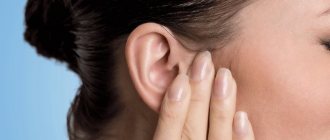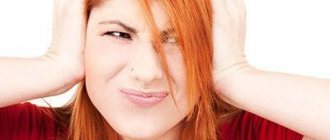Inflammation
Inflammatory causes of ear congestion:
- external otitis of any etiology (fungal, bacterial, viral);
- eustacheitis (tubootitis);
- catarrhal otitis media, bullous otitis (with influenza);
- purulent otitis media (including chronic);
- exudative otitis;
- adhesive otitis media
With inflammation in the nasal cavity, paranasal sinuses or pharynx, swelling of the nasopharyngeal mouth of the auditory tube occurs, due to which the pressure in the tympanic cavity and the environment ceases to equalize, and the drainage function of the auditory tube is disrupted. The infectious agent, together with the discharged contents from the nasal cavity and paranasal (paranasal) sinuses, enters the auditory tube and tympanic cavity, causing inflammation of the auditory tube - eustacheitis (tubo-otitis) and otitis media.
Due to inflammation, swelling of the mucous membrane of the middle ear and eardrum occurs, sound-conducting mechanisms stop working normally, and ear congestion occurs, and hearing decreases. A common cause of dysfunction of the auditory tube and the development of otitis in children is hypertrophy of the nasopharyngeal tonsil and adenoiditis. In adults, vasomotor and allergic rhinitis and deviated septum are common causes of swelling at the mouth of the auditory tube. The cause may also be a violation of blood circulation and innervation in the inner ear.
With inflammation in the external auditory canal, swelling of its walls appears, fungal or purulent masses clog the ear canal, and the surface layers of the eardrum become inflamed (myrinigitis). Because of this, the mobility of the eardrum, necessary for proper sound transmission, is reduced.
Most of the described forms of otitis often occur as complications of acute respiratory diseases, sinusitis, rhinitis, especially in the case of improper cleansing of the nasal cavity. In addition to the feeling of congestion during otitis media, shooting, sharp or aching pains, hearing problems, bloody, fungal, purulent discharge, itching, a feeling of pulsation or fluid transfusion in the ear can be added.
A feeling of ear fullness also occurs when:
- water getting into the ears (usually when swimming), the water usually evacuates on its own and does not require intervention;
- when a cerumen or epithelial plug forms (can also occur after water gets into the ear due to swelling of the cerumen plug);
- foreign bodies getting into the ears: insects, earbuds, cotton wool from cosmetic sticks, etc.
After eliminating the provoking factor, the discomfort disappears and hearing is restored.
Sensorineural hearing loss
The cause of hearing loss and a feeling of fullness in the ears may be sensorineural hearing loss, which occurs as a result of a violation of the blood supply or innervation in the inner ear.
Sensorineural hearing loss can result from:
- changes in blood pressure due to hypertension;
- acute viral diseases;
- barotrauma;
- fracture of the base of the skull;
- ischemia of the central areas of the auditory analyzer;
- neuroma of the vestibulocochlear nerve;
- compression from the outside by neoplasms and vascular aneurysms.
What diseases lead to noise and congestion?
If your ears are blocked and the buzzing in them does not stop, this may indicate pathological processes taking place in the body.
What diseases can occur with such symptoms?
Otitis - inflammation of the outer and middle parts of the hearing organ is a common cause of these unpleasant symptoms. Another characteristic manifestation of otitis media is acute shooting pain during inflammation. The disease may also be accompanied by fever and purulent discharge from the ear canal.
Friends! Timely and correct treatment will ensure you a speedy recovery!
A feeling of congestion can appear with a disease of the hearing organ such as labyrinthitis - an inflammatory process that affects the structures of the inner ear. Another internal disease is Meniere's disease. With Meniere's disease, in addition to congestion, the following symptoms appear: headaches, nausea, problems with balance (at times of exacerbation, the patient cannot even sit).
Make an appointment right now!
Call us by phone or use the feedback form
Sign up
With neuritis of the auditory nerve, in addition to ear noise and a feeling of fullness, the patient complains of frequent dizziness.
Older adults are often diagnosed with otosclerosis, a condition in which the bone in the middle portion of the ear becomes enlarged, leading to hearing problems.
But not only ear diseases lead to such symptoms.
If this condition does not go away for a long time and is not associated with the organ of hearing, it is necessary to examine the body for the presence of diseases such as diseases of the thyroid gland, kidneys, osteochondrosis, and diabetes mellitus.
Symptoms of ear congestion
Associated symptoms for various ear diseases:
| Cause | Symptoms | |||||||
| Pain | Ear discharge | Itching | Hearing loss | Autophony | Noise | Sensation of fluid transfusion | Manifestations of general intoxication | |
| Sulfur plug | No | No | Not really | Yes | Not really | Not really | No | No |
| Otitis externa | Yes | Not really | Yes | Yes | Not really | No | No | Not really |
| Tubootitis | Not really | No | No | Yes | Yes | Not really | No | Not really |
| Otitis media | Yes | No | No | Yes | Yes | Not really | No | Yes |
| Suppurative otitis media | Yes | Yes | Not really | Yes | Not really | Not really | No | Yes |
| Exudative otitis media | No | No | No | Yes | Yes | Not really | Yes | No |
| Sensorineural hearing loss | No | No | No | Yes | Not really | Yes | No | No |
Headache as a symptom of a cold
Headaches due to colds are usually localized in the area of the eyeballs and forehead. It can be either unilateral or bilateral. The pain is moderate, but if complications develop, it can intensify, causing significant physical discomfort. If, during cephalalgia, mucous discharge from the nose becomes more abundant, this may indicate the spread of a viral infection to the nasopharynx. Headache, cough, runny nose, which do not improve with antiviral treatment, often indicate the occurrence of sinusitis. A dry or wet cough, sore throat and fever may also occur. These additional signs indicate a complex course of the cold and complications of respiratory viral diseases with laryngitis, sore throat or bronchitis - depending on the intensity of additional manifestations of the disease. A throbbing headache may indicate the development of a dangerous complication - meningitis, especially if the attacks are accompanied by vomiting. A headache with a cold without fever may indicate a weakening of the body’s defenses or a high risk of latent infectious diseases.
Diagnosis of ear congestion
Standard examinations for any ear pathology:
- video endoscopy or microscopy of the ear;
- video endoscopy of the nose and nasopharynx;
- audiometry;
- tympanometry;
If necessary, additional studies are prescribed:
- computed tomography or magnetic resonance imaging of the temporal bones and brain;
- culture of nasal discharge and external auditory canal for flora and sensitivity to antibiotics;
- general blood test, blood glucose (other additional laboratory tests are possible after consulting a doctor);
- Doppler ultrasound of neck vessels;
- consultations with other specialists.
Diagnostics
Ear congestion is an indication for visiting an otolaryngologist, who conducts a full examination of the hearing analyzer in order to determine the cause of the unpleasant symptoms. Laboratory and instrumental studies are aimed at studying the degree of hearing impairment and morphofunctional changes in various parts of the ear. The following have the greatest diagnostic value:
- Instrumental examination of the external ear
. During otoscopy, inflammatory changes, pathological discharge, cracks or ruptures of the eardrum are detected. To clarify the cause of congestion, microotoscopy is additionally prescribed. - Audiometry
. The degree of dysfunction of the auditory analyzer is assessed using a special device that produces sounds of varying frequencies and volumes. To detect damage to the middle and inner ear, impedance audiometry and tuning fork tests are used. - Assessment of patency of the auditory tube
. Excluding eustachitis involves performing special tests: with an empty throat, Toynbee maneuver or Valsalva maneuver. To objectively study the patency of the Eustachian tube, it is blown through, followed by otoscopy or audiometry. - Laboratory methods
. Discharge from the external auditory canal is collected for bacteriological culture and identification of pathogenic microorganisms. A general blood test is indicative of identifying signs of inflammation. In the presence of a general infectious syndrome, serological diagnostics (ELISA, RIF, PCR) can be used.
For suspected vascular disorders in the organ of hearing, Dopplerography and rheoencephalography are recommended. The presence of neurological symptoms serves as the basis for a CT scan of the skull, MRI of the head, and electroencephalography. If an allergic nature of the disorder is suspected, allergy tests are performed. Patients are also referred for a comprehensive examination to a neurologist and for consultations with other specialists.
Otoscopy for ear congestion
Treatment
Treatment for ear congestion and otitis media involves treating the underlying cause of the disease:
- in case of an inflammatory process in the nasal cavity and paranasal sinuses, antibacterial therapy is prescribed, in addition, lavage of the nasal cavity is prescribed, which eliminates the discharge of discharge into the auditory tube during self-washing, treatment with a YAMIK catheter, puncture of the maxillary sinuses, physiotherapy;
- if a chronic pathology of the nasal cavity or nasopharynx is detected, leading to the closure of the mouth of the auditory tube, surgical treatment is performed (adenotomy, vasotomy, septoplasty, etc.);
- To remove wax plugs or foreign bodies, the doctor performs lavage (under visual control) or instrumental removal of the foreign body;
- for external otitis, the outer ear is washed and its walls are treated with antifungal and antibacterial drugs;
- in case of dysfunction of the auditory tube or exudate in the tympanic cavity, medical procedures are necessary: pneumomassage of the tympal membrane, blowing of the ears according to Politzer, catheterization of the eustachian tube, paracentesis or shunting of the eardrum;
- for sensorineural (sensorineural) hearing loss, a course of vascular and vitamin therapy is prescribed to improve the nutrition of the inner ear and brain.
Basic treatment regimens for ear pathology*
| Pathology | Basic treatment methods |
| Sulfur plug | Removal by rinsing or instrumental removal. |
| Otitis externa | Toilet of the external auditory canal, treatment with medications, ear drops, vasoconstrictor nasal sprays, systemic antibacterial or antifungal therapy, FTL**. |
| Tubootitis | Vasoconstrictor nasal sprays, blowing of the eustachian tubes according to Politzer, pneumomassage of the eardrum, FTL**, catheterization of the auditory tubes if necessary. |
| Otitis media | Vasoconstrictor nasal sprays, systemic antibacterial therapy, ear drops, Politzer ear blowing, pneumomassage of the eardrum, FTL**, if necessary, catheterization of the auditory tubes, lavage of the nasal cavity using the moving method. If necessary, surgical treatment - eardrum bypass or paracentesis. Complemented by the treatment of diseases of the ENT organs. |
| Suppurative otitis media | Vasoconstrictor nasal sprays, systemic antibacterial therapy, ear drops, Politzer blowing, if necessary, transtympanic injection of drugs, catheterization of auditory tubes, nasal lavage using the displacement method. If necessary, surgical treatment - eardrum bypass or paracentesis and other operations, FTL**. It is supplemented by treatment of pathologies of the nasal cavity, nasopharynx and paranasal sinuses, if indicated. |
| Exudative otitis media | Vasoconstrictor nasal sprays, mucolytics, Politzer blowing, catheterization of auditory tubes. If necessary, surgical treatment - eardrum bypass or paracentesis, FTL**. It is complemented by the treatment of pathologies of the nasal cavity, nasopharynx and paranasal sinuses. |
| Sensorineural hearing loss | Catheterization of auditory tubes, systemic vascular and vitamin therapy. |
*These treatment regimens are not a recommendation for self-treatment and serve to familiarize patients with basic treatment methods. The final decision on treatment and examination methods is made by the doctor after the examination!
** FTL – physiotherapeutic treatment.
When is it necessary to consult an ENT doctor?
Situations where unpleasant symptoms in the ear cavity go away on their own are rather an exception to the rule. If congestion and noise do not go away for a long time, hearing problems begin, if pain, nausea, dizziness and loss of balance appear - all this is a good reason to contact an otolaryngologist to determine the cause of this condition and prescribe effective treatment.
To determine the correct treatment tactics, a diagnosis is first carried out, which may include examination of the ear cavity, endoscopic, audiometric, and tympanometric studies. If necessary, a computed tomography scan is prescribed. In some cases, consultations with related specialists, for example, a neurologist, are required.
Depending on the diagnosis, a treatment regimen is prescribed.










